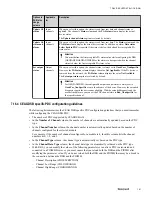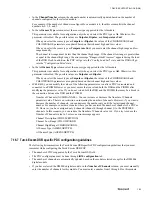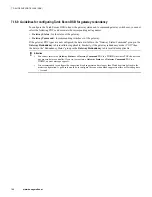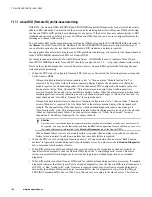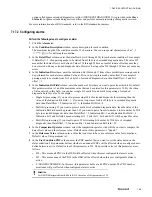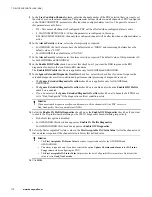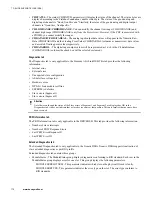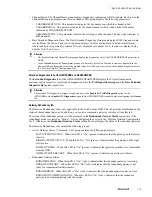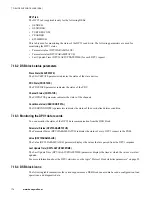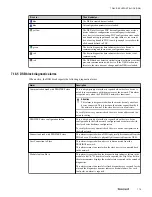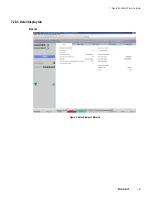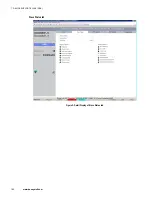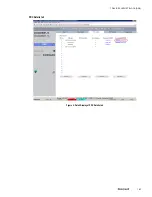
7.17.1 About RIO (Remote IO) profile-based alarming
With R410, the Generic DSBs (GENDSB and GENIODSB) support RIO diagnostics for devices which strictly
adhere to RIO standards. You must check the device and its alarming behavior with Generic DSB before using
the Generic DSB for RIO profile-based alarming for any device. If the device does not conform strictly to RIO
standards and cannot be qualified to be used with Generic DSB, then you can use user-configurable alarms for
alarming and channel status setting.
You can enable RIO profile based-alarming for Generic DSB by selecting the ENABLERIOPROF parameter in
the
Alarms
tab of the Generic DSBs. By default, the ENABLERIOPROF parameter is disabled. However, if
you enable this option for devices that do not conform to RIO standards, an alarm is reported.
For appropriate channel status setting in case of RIO profile-based alarming, you must enter the channel number
in the CHNNUMBER parameter of PDCs of Generic DSB.
For example channel numbers for Turck DSB starts from 1. If GENDSB is used to configure Turck IO rack,
then CHNNUMBER parameter for each PDC should be configured as 1,2,3,… for proper channel status setting.
Based on the extended diagnostics received from slave device, Generic DSBs perform the following channel
status and alarm processing.
• When the PDC state is Configured, Opening PDC delivery, or Connected, the following alarms are reported
by the Generic DSBs.
– If diagnostic data indicates failure in module in slot “n,” then an alarm “Module fault on Slot” is
reported. The Trip Value field in the alarm summary display displays the slot number of the faulty
module reported in extended diagnostics. All the channels of PDC configured with module in the slot
having alarm will go “Bad_Nonspecific.” This alarm returns to normal when fresh diagnostics is
received from the device and it does not indicate module failure. When the alarm returns to normal after
fresh diagnostic are received indicating no error, all channel status changes to “Good_NonCascade” for
input channels and “GoodCasc_Nonspecific” for output channels.
– If diagnostic data indicates fault in channels of module configured in slot “n,” then an alarm “Channels
errors of Module” is reported. The Trip Value field in the alarm summary displays the slot number of
module. The channel status of the channels for which extended diagnostic reports error changes to
“Bad_Nonspecific” state. This alarm returns to normal when fresh diagnostic is received for the slot and
it does not indicate channel failure. The channel status changes to “Good_NonCascade” for input
channels and “GoodCasc_NonSpecific” for output channels.
Attention
Note that even if extended diagnostic reports more than one channel of module as faulty, only one alarm will
be reported. You can view the faulty channels from the
PDC
tab configuration form. In addition, you can view
the extended diagnostic information in the
Extended Diagnostics
tab of the Generic DSBs.
– When channel failure is active and module failure is reported, then an alarm is reported due to channel
failure return to normal. In addition, an alarm due to module failure is reported.
• When the PDC is not in Configured, Opening delivery, or Connected state, then an alarm “Rack Fault on
module” is reported if extended diagnostic reports module errors. You must view the
Extended Diagnostics
tab to determine which module is faulty.
• When RIO profile is enabled and if diagnostic received could not be recognized as channel, module, or
identifier-related diagnostic, then the Generic DSBs report the “Corrupt diagnostic” alarm. This alarm
returns to normal after fresh diagnostic is received having proper extended diagnostic or no extended
diagnostic.
• When RIO profile is enabled, Generic DSBs look for reliable extended diagnostic for processing. If standard
diagnostic indicates that there is overflow in extended diagnostics, then the Generic DSB sets all channels of
all PDCs to “Bad_NonSpecific” state. No alarm is reported in this case. Overflow in extended diagnostic
means that the number of diagnostic bytes increased buffer size for diagnostic in slave. Note that though
PROFIBUS standard buffer size is of 244 bytes, this can vary according to the slave devices. Therefore, an
7 DEVICE SUPPORT BLOCK (DSB)
168
www.honeywell.com
Summary of Contents for Experion PKS
Page 1: ...Experion PKS PROFIBUS Gateway Module User s Guide EPDOC XX88 en 431E June 2018 Release 431 ...
Page 8: ...CONTENTS 8 www honeywell com ...
Page 10: ...1 ABOUT THIS GUIDE 10 www honeywell com ...
Page 32: ...4 PROFIBUS GATEWAY MODULE PGM INSTALLATION 32 www honeywell com ...
Page 58: ...5 PROFIBUS GATEWAY MODULE PGM BLOCK 58 www honeywell com ...
Page 69: ...6 PROTOCOL BLOCK 69 ...
Page 103: ...5 Click OK 6 PROTOCOL BLOCK 103 ...
Page 110: ...6 PROTOCOL BLOCK 110 www honeywell com ...
Page 183: ...PDC Details tab Figure 6 Detail Display of PDC Details tab 7 DEVICE SUPPORT BLOCK DSB 183 ...
Page 186: ...7 DEVICE SUPPORT BLOCK DSB 186 www honeywell com ...
Page 231: ...9 PROFIBUS I O MODULE PIOMB FUNCTION BLOCK 231 ...
Page 232: ...9 PROFIBUS I O MODULE PIOMB FUNCTION BLOCK 232 www honeywell com ...
Page 236: ...10 PROFIBUS GATEWAY MODULE PGM CONFIGURATION EXAMPLE 236 www honeywell com ...
Page 264: ...13 PROFIBUS GATEWAY MODULE PGM TROUBLESHOOTING 264 www honeywell com ...








